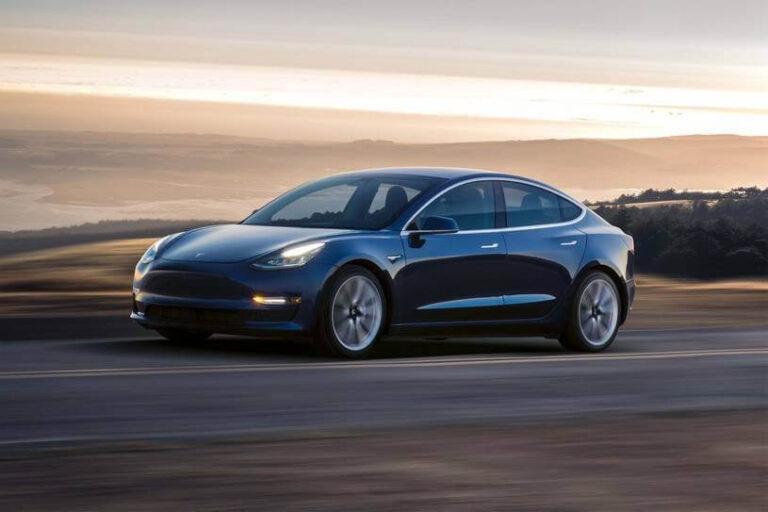On Nov. 19, 2017, Tesla unveiled the Roadster 2.0. A four-seat coupe, it flies from 0 to 60 mph in 1.9 seconds. It has a top speed of over 250 mph. It has a highway range of 620 miles. “The point of all this,” Elon Musk said, “is just to give a hardcore smackdown to gasoline cars.”
Fifteen years ago, electric vehicles (EVs) were dismissed as over-sized golf carts, incapable of meaningful range, resembling Star Trek’s USS Enterprise in appearance. There’s been a dramatic shift since. Virtually every automaker has announced a sleeker EV production model or, in cases such as Volkswagen, a lineup of them. New EV automakers such as Rivian and NIO have emerged with aspirations of mass production. In the long run, it’s now clear that EVs will fully replace internal combustion engine (ICE) vehicles.
But some automakers would rather die than make the transition – and a few probably will.
In this essay, I will explain the three primary reasons why society will shift to EVs: 1) they’re easier to maintain; 2) they’re cheaper to own; and 3) they’re safer too.
Then I will explain the three forces causing automakers to resist transitioning entirely to EV production: 1) high switching costs; 2) overprotection of a profitable business line; and 3) overreliance on a dealership distribution model that has a disincentive to sell EVs.
Finally, I will give examples of automakers that could be crippled by these forces.
My hope for this essay was to offer a broad contrast between EV and ICE producers. Unfortunately, Tesla is currently the only EV producer that is demonstrating what’s possible from a physics and business perspective. Therefore, I’ll often use it as a proxy for EVs. Over time I expect other EV-makers to start catching up.
Easier
EV motors need servicing like Tom Brady and Gisele Bündchen need better-looking spouses. ICE vehicles require regular services to change to oil, coolant and transmission fluids, and timing belts as well. EVs require none of these. ICE cars require ongoing emissions testing. EVs don’t. In my research, I could not find a single service item that EVs require that ICE vehicles don’t. The big potential servicing an EV requires is a change of battery. This concern has been nullified by well-engineered battery cells and thermal management systems. For example, after about 100,000 miles, Tesla Model S and X battery packs retained about 92 percent of their capacity.
ICE cars require trips to the gas station. EV owners simply plug their car into an outlet at home. If you’re not going on road trips, this adds up to significant time savings. To be fair, it’s a different story for long road trips. EVs take far longer to refuel than ICE vehicles. For example, a trip from Phoenix to San Diego in a Tesla Model 3 Standard Range requires a 55-minute recharge in Yuma. You could argue that on a 5-hour, 20-minute drive you would take a 30- to 40-minute break anyway, but suffice to say that with current technology, recharging an EV on road trips may slow you down.
Cheaper
There are four primary components to the cost of owning a vehicle: purchase price, maintenance, fuel, and resale value. EV’s are generally more expensive to buy, but more than make up for it on the remaining three components. Let’s compare a Tesla Model 3 Standard Range+ to a Honda Accord Touring. After 5 years, the Tesla’s resale value represents 48% of its initial purchase while Honda’s resale value represents 38% of its purchase price. The Tesla maintenance costs are also $2,600 lower than the Honda’s. In terms of bottom-line, total-cost of ownership, it costs about $7,000 less to own it over 5 years than it does a Honda f******Accord! This isn’t an exception either. Here’s an Excel spreadsheet that allows you to compare cost of ownership of other EV’s with other ICE vehicles.
Over time the purchase price of EV’s will fall significantly, because economies of scale are pushing down the cost of batteries – an EV’s most expensive component. The accepted wisdom in the auto industry is that at $100 per kilowatt hour (kWh), EV’s will reach price parity with ICE vehicles. BloombergNEF, an energy research organization, expects this to occur by about 2024.
Safer
Have you seen an electric car motor before? It’s minuscule compared to a gasoline engine. An electric motor sits between the wheels of an EV, and notably does not swallow up space underneath the hood. Where’s the benefit in that? This creates room for a front trunk – and more importantly, a sacrificial crumple zone. Hold your breath for three sentences that explain why that matters from a physics perspective.
A front-end collision creates a dangerous change in momentum equal to mass times acceleration. A front crumple zone extends the duration of the force being applied – much like an airbag. This lowers the value of the change in momentum and the collision becomes less dangerous. I don’t know if Jesus would’ve driven an EV but I guarantee Newton would’ve.
An EV with a 75-kWh battery pack will have about 320 miles of range – a fairly comparable range to an ICE vehicle. A battery pack of that size weighs roughly 1,000 pounds – and EV engineers pack that weight along the bottom of the car, sitting less than a foot off the ground. The result is an extremely low center of gravity that reduces the probability of rollover. Why is that important? According to NHTSA’s SaferCar.gov, 35 percent of all automobile fatalities involve rollovers.
You’ve probably seen gasoline resupply trucks around town with colorful warning signs that read, “DANGER- FLAMMABLE LIQUID.” We probably should all be driving around with one. According to the U.S. Department of Transportation, there is one vehicle fire for every 19 million miles traveled. From 2012 to 2018 there was a Tesla vehicle fire for every 170 million miles traveled – an improvement by a factor of nine. When vehicles don’t travel around with gallons of flammable liquids, there are fewer vehicle fires. How common sense is that?
An Automaker’s Headache
So why aren’t all automakers going all-in on electric?
The first reason is the cost of switching to EV production. There is a vicious cycle in the auto industry that works like this: High switching costs, in the form of capital expenditures and research and development, are required reach economies of scale and profitability in EVs. To minimize those Capex and R&D costs, automakers are opting to produce a smaller lineup of EVs. This keeps their battery costs high – which as you already know is an EV’s most expensive component. Higher battery costs lead to lower margins, and lower margins lead to lower profitability. Lower profitability makes EVs seem less attractive to automakers, so the slow switch continues.
In 2017 McKinsey produced a report (annoyingly called “Electrifying insights”) that describes this battery barrier: “Unfavorable battery economics will remain a profitability barrier for the next two to three product cycles. Although battery prices have declined by ~80% since 2010, the 2016 estimated pack cost of ~$227/kWh means that a 60-kWh battery becomes a $13,600 component of the car.” It continues: “Under a range of scenarios for future battery cost reductions, cars in the C/D segment in the US might not reach true price parity with ICE vehicles (without incentives) until between 2025 and 2030, when battery pack costs fall below $100/kWh, creating financial headwinds for automakers for the next two to three product cycles.”
Why are battery costs so high? In 2016 Elon Musk explained, “One way to think of manufacturing efficiency is how long a journey did that molecule take since it was mined. If it gets mined, travels across the world, gets processed, then travels back across the world until it ends up being assembled, that’s obviously going to be expensive.”
The solution is a one-stop shop for battery production to minimize costs. But how big does it need to be? If an average EV is going to have a 75-kWh battery pack and you want to produce, for example, one million vehicles per year, simple math indicates you’re going to need 75 gigawatt hours (GWh) of batteries per year. In 2014 the entire world’s battery production capacity was 40 GWh. For Tesla, the solution was the Gigafactory in Nevada, a $5-billion factory designed to take raw material in and push 105 GWh of battery packs out. Not many automakers are willing to commit sums that large to the battery production needed to make their EVs compelling. The lackluster commitment shows up in the vehicles.
“They’re saying, we’ll just get something into the marketplace, and they put it into the marketplace, and it’s not really an electric car,” said Sandy Munro, the acclaimed Detroit auto specialist. “It’s kind of like somebody’s impression of how electric cars should be. And it’s using kludgey (sic) materials. They try to squeeze an old way of doing business into a new product. You can’t do that. It won’t work.”
Legacy automakers need to round the bases with research and capital commitment for EVs in order to see healthy profits. Unfortunately, many are stopping at first base and neither shareholders nor consumers are left satisfied.
Follow the Money
The second reason automakers aren’t switching to EVs is the juicy profit margins that ICE vehicles generate.
What could be more disastrous to a legacy auto executive’s compensation than a drop in earnings per share as a result of switching to a not-yet-profitable EV lineup? What could be riskier to an auto-executive’s job than switching from a proven ICE business model to an unproven EV business model? It’s an interesting phenomenon – most legacy auto executives concede that the future is a non-ICE vehicle, but given their personal calculus, they’re are unwilling to make the change. It’s like St. Augustine, who once said, “Oh Lord, make me chaste – but not yet.”
The story of business leaders failing to adapt to change because of an incentive to protect profitability has played out before. My favorite example comes from the brilliant Edwin Land of Polaroid. Land was a Nobel-winning visionary – the inventor of polarized lens and instant-print photography.
Under Land, Polaroid’s instant-print photography was a gigantic success. Sales grew from $1.5 million in 1948 to $1.4 billion in 1978 – a growth rate of 25.6 percent compounded annually. However, by the mid 1980s, competitors began producing digital cameras, which slowly but surely put the instant-print business to sleep. It wasn’t until 1996, a full ten years later, that Polaroid unveiled its own digital camera. It was too little too late. Polaroid filed bankruptcy in 2001.
What makes this story remarkable is that Edwin Land learned about the merits of digital photography in 1954 – a full thirty years before the first digital cameras came to market. The story goes like this: In 1953, President Eisenhower created a panel of experts to study the possibility of nuclear attack by the Soviet Union and Land was invited. The panel quickly determined it would need a means of gathering data, so it developed digital photography technology for the U-2, the world’s first spy-plane. Having created a perfectly successful technological development, why didn’t Land and his team implement digital camera technology for his Polaroid consumers? “Cameras generated much less income than their instant-print cartridges,” Safi Bahcall explains in Loonshots, “With digital, there was no film. ‘There’s no way that can make any money.’ they said.”
Polaroid, like today’s legacy automakers, chose to prioritize profitability over products that maximize benefits to consumers, and it paid the price. And speaking of not caring much about the consumer …
Automobile Dealerships
A third reason automakers are slow to make the EV shift is their overreliance on traditional car dealerships. According to the National Automobile Dealers Association (NADA), 16,682 franchised dealers sold 17.1 million light-duty vehicles in 2019. This figure represents virtually all U.S. light-duty vehicles sales. (“Light duty” includes passenger cars and light trucks.) Clearly, automakers rely on dealerships to sell their vehicles. Why is this a problem?
Let’s take a quick look underneath the financial hood of auto dealerships. According to NADA, 87.5 percent of revenue comes from selling vehicles, and only 12.5 percent comes from service. But the profit margins on selling cars are thin, while the profit margins on service maintenance are fat. In other words, the auto dealership business is a lot like the printer business, which sells you a printer at a small profit in order to make a larger ongoing profit on ink cartridges. That meager service business creates a whopping 50 percent of a dealership’s total profit.
This means dealers have every financial incentive to sell a vehicle that requires service. A Canadian study by the 2 Degree Institute found that EVs required roughly 50 percent less in maintenance costs over 10 years than an ICE vehicle. By that math, if auto dealers switched to selling all EVs, they could kiss 25 percent of their profits goodbye. If you told your barber you wanted to switch from the once-a-month haircut to the once-every-two-months haircut, you would get pushback – and that’s exactly what EV consumers face at the dealership.
A 2015 New York Times article on electric vehicles sales at dealerships conveys the widespread consumer unhappiness that results. “According to Dr. Cahill,” the article said, “a 2013 J.D. Power survey found that electric-car buyers were significantly less satisfied with their car dealer than were buyers of traditional cars. Consumer Reports last year published results from a secret shopper survey in which its representatives visited dealers around the country and found, for example, a Toyota salesperson in Bayside, Queens, who would not even show a Prius plug-in that the dealer had in stock, and a Ford dealer in Manhattan who denied that Ford offered an electric Focus model (not true).”
If car dealerships suppress EV sales, it makes it appear to automakers that there is lackluster demand. If automakers see lackluster demand, they have little reason to accelerate transition to EVs, so the slow switch continues.
Which brings us to our final topic: Which automakers are switching so slowly, or denying the EV transition so stubbornly, that they may face an existential crisis?
Automakers in Jeopardy
Let’s look at three examples of automakers that are subject to all three of these forces and hear what their executives have to say on EVs.
Mazda: “We need to have the internal combustion engine,” Deputy General Manager of Products Kenichiro Saruwatari told Motoring. “Even beyond 2050 we will still utilize the combustion engine.” Mazda has no large-scale battery factory under construction, and just one EV model that features a dazzling 130 miles of range.
Honda: “EV’s will not be mainstream,” Honda Canada CEO Takahiro Hackigo told Automotive News in 2019. Honda has no large-scale battery factory coming and zero EVs lined up for the U.S. market until at least 2025.
Toyota: In 2019, Toyota’s Group Vice President and General Manager Jack Hollis said, “I don’t think there’s any proof in the marketplace that there’s a demand for EVs.” He continued, “When I see what the capabilities of the technology, be it battery EV or fuel cell, I get excited because I think the consumer will end up winning. But later. It’s just not this second.”
Someone should tell Mr. Hollis the Polaroid story.
In the long run, EVs will fully replace ICE vehicles – but some automakers would rather die than make the transition, and a few probably will. Vehicle owners will gain significant benefits by adopting EVs: they will enjoy lower cost of ownership, greater ease of ownership, and superior safety versus an ICE.
Despite these benefits, legacy automakers are slow to transition due to high switching costs, overprotection of their profitable ICE vehicle lines, and an overreliance on the dealership network, which tries to avoid selling EVs over ICE vehicles because of its lower profit potential.
With new EV carmakers like Rivian, Lucid, and Faraday Future emerging, the future for EVs is getting brighter. By the same token, the days of the gasoline engine are numbered and some of the legacy automakers with it.
History won’t repeat itself, but it will rhyme. I think it’s likely that someday a popular legacy automaker of today will shutter its doors due to failure to make a timely transition to EV production. I imagine generations from now there will be tourists going through an old ICE vehicle factory, where they might see hundreds of unsold gasoline engines in stockpiles and ask, “Why were they making these engines if they knew electric was better?” And the tour guide will offer an explanatory quote from Edwin Land, who once took a visitor to his office and showed him his stockpile of unsold Polaroid cameras. “This is what hubris looks like,” he said.
—–
Postscript: There is little awareness in the public mind-space that battery technology is rapidly evolving. From the perspectives of cost, energy density, and environmental impact, there is a long runway in developing battery technology. Public and private research development are consistently pushing new boundaries. Look out for Tesla’s “Battery Day” presentation in the immediate future. I expect the company to unveil its recent battery tech developments and roadmap for the future. This may include 1) battery cell costs below $100 per kWh; 2) battery longevity up to 1 million miles; 3) removal of cobalt from battery cell chemistry; 4) implementation of ultracapacitor or dry electrode technology; 5) a battery manufacturing plant in Texas capable of producing 1 Terawatt-hour of capacity (1,000 GWh). This would be twenty-five times the entire world’s production capacity in 2014.
Disclosure:
Farnam Financial LLC (“Farnam”) is a registered investment advisor offering advisory services in the State of Arizona and in other jurisdictions where exempted. Registration does not imply a certain level of skill or training. The presence of this website on the Internet shall not be directly or indirectly interpreted as a solicitation of investment advisory services to persons of another jurisdiction unless otherwise permitted by statute. Follow-up or individualized responses to consumers in a particular state by Farnam in the rendering of personalized investment advice for compensation shall not be made without our first complying with jurisdiction requirements or pursuant an applicable state exemption.
All written content on this site is for information purposes only. Opinions expressed herein are solely those of Farnam, unless otherwise specifically cited. Material presented is believed to be from reliable sources and no representations are made by our firm as to other parties’ informational accuracy or completeness. All information or ideas provided should be discussed in detail with an advisor, accountant or legal counsel prior to implementation.
Sources
BAHCALL, SAFI. LOONSHOTS: Nurture the Crazy Ideas That Win Wars, Cure Diseases, and Transform Industries. GRIFFIN, 2020.
http://hyperphysics.phy-astr.gsu.edu/hbase/impulse.html
https://www.nada.org/WorkArea/DownloadAsset.aspx?id=21474861098
https://www.nytimes.com/2015/12/01/science/electric-car-auto-dealers.html




